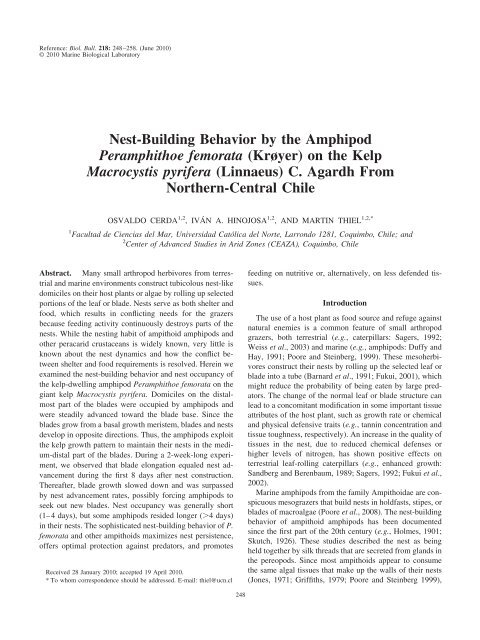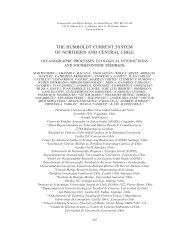Nest-Building Behavior by the Amphipod Peramphithoe ... - Bedim
Nest-Building Behavior by the Amphipod Peramphithoe ... - Bedim
Nest-Building Behavior by the Amphipod Peramphithoe ... - Bedim
You also want an ePaper? Increase the reach of your titles
YUMPU automatically turns print PDFs into web optimized ePapers that Google loves.
Reference: Biol. Bull. 218: 248–258. (June 2010)<br />
© 2010 Marine Biological Laboratory<br />
<strong>Nest</strong>-<strong>Building</strong> <strong>Behavior</strong> <strong>by</strong> <strong>the</strong> <strong>Amphipod</strong><br />
<strong>Peramphithoe</strong> femorata (Krøyer) on <strong>the</strong> Kelp<br />
Macrocystis pyrifera (Linnaeus) C. Agardh From<br />
Nor<strong>the</strong>rn-Central Chile<br />
OSVALDO CERDA 1,2 , IVÁN A. HINOJOSA 1,2 , AND MARTIN THIEL 1,2,*<br />
1 Facultad de Ciencias del Mar, Universidad Católica del Norte, Larrondo 1281, Coquimbo, Chile; and<br />
2 Center of Advanced Studies in Arid Zones (CEAZA), Coquimbo, Chile<br />
Abstract. Many small arthropod herbivores from terrestrial<br />
and marine environments construct tubicolous nest-like<br />
domiciles on <strong>the</strong>ir host plants or algae <strong>by</strong> rolling up selected<br />
portions of <strong>the</strong> leaf or blade. <strong>Nest</strong>s serve as both shelter and<br />
food, which results in conflicting needs for <strong>the</strong> grazers<br />
because feeding activity continuously destroys parts of <strong>the</strong><br />
nests. While <strong>the</strong> nesting habit of ampithoid amphipods and<br />
o<strong>the</strong>r peracarid crustaceans is widely known, very little is<br />
known about <strong>the</strong> nest dynamics and how <strong>the</strong> conflict between<br />
shelter and food requirements is resolved. Herein we<br />
examined <strong>the</strong> nest-building behavior and nest occupancy of<br />
<strong>the</strong> kelp-dwelling amphipod <strong>Peramphithoe</strong> femorata on <strong>the</strong><br />
giant kelp Macrocystis pyrifera. Domiciles on <strong>the</strong> distalmost<br />
part of <strong>the</strong> blades were occupied <strong>by</strong> amphipods and<br />
were steadily advanced toward <strong>the</strong> blade base. Since <strong>the</strong><br />
blades grow from a basal growth meristem, blades and nests<br />
develop in opposite directions. Thus, <strong>the</strong> amphipods exploit<br />
<strong>the</strong> kelp growth pattern to maintain <strong>the</strong>ir nests in <strong>the</strong> medium-distal<br />
part of <strong>the</strong> blades. During a 2-week-long experiment,<br />
we observed that blade elongation equaled nest advancement<br />
during <strong>the</strong> first 8 days after nest construction.<br />
Thereafter, blade growth slowed down and was surpassed<br />
<strong>by</strong> nest advancement rates, possibly forcing amphipods to<br />
seek out new blades. <strong>Nest</strong> occupancy was generally short<br />
(1–4 days), but some amphipods resided longer (4 days)<br />
in <strong>the</strong>ir nests. The sophisticated nest-building behavior of P.<br />
femorata and o<strong>the</strong>r ampithoids maximizes nest persistence,<br />
offers optimal protection against predators, and promotes<br />
Received 28 January 2010; accepted 19 April 2010.<br />
* To whom correspondence should be addressed. E-mail: thiel@ucn.cl<br />
feeding on nutritive or, alternatively, on less defended tissues.<br />
Introduction<br />
The use of a host plant as food source and refuge against<br />
natural enemies is a common feature of small arthropod<br />
grazers, both terrestrial (e.g., caterpillars: Sagers, 1992;<br />
Weiss et al., 2003) and marine (e.g., amphipods: Duffy and<br />
Hay, 1991; Poore and Steinberg, 1999). These mesoherbivores<br />
construct <strong>the</strong>ir nests <strong>by</strong> rolling up <strong>the</strong> selected leaf or<br />
blade into a tube (Barnard et al., 1991; Fukui, 2001), which<br />
might reduce <strong>the</strong> probability of being eaten <strong>by</strong> large predators.<br />
The change of <strong>the</strong> normal leaf or blade structure can<br />
lead to a concomitant modification in some important tissue<br />
attributes of <strong>the</strong> host plant, such as growth rate or chemical<br />
and physical defensive traits (e.g., tannin concentration and<br />
tissue toughness, respectively). An increase in <strong>the</strong> quality of<br />
tissues in <strong>the</strong> nest, due to reduced chemical defenses or<br />
higher levels of nitrogen, has shown positive effects on<br />
terrestrial leaf-rolling caterpillars (e.g., enhanced growth:<br />
Sandberg and Berenbaum, 1989; Sagers, 1992; Fukui et al.,<br />
2002).<br />
Marine amphipods from <strong>the</strong> family Ampithoidae are conspicuous<br />
mesograzers that build nests in holdfasts, stipes, or<br />
blades of macroalgae (Poore et al., 2008). The nest-building<br />
behavior of ampithoid amphipods has been documented<br />
since <strong>the</strong> first part of <strong>the</strong> 20th century (e.g., Holmes, 1901;<br />
Skutch, 1926). These studies described <strong>the</strong> nest as being<br />
held toge<strong>the</strong>r <strong>by</strong> silk threads that are secreted from glands in<br />
<strong>the</strong> pereopods. Since most ampithoids appear to consume<br />
<strong>the</strong> same algal tissues that make up <strong>the</strong> walls of <strong>the</strong>ir nests<br />
(Jones, 1971; Griffiths, 1979; Poore and Steinberg 1999),<br />
248










